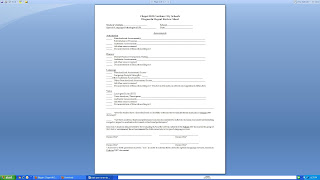After a few of my articles have been published about therapy data documentation, one of which you can see
here, I've received a few polite inquiring emails. Every one of these email authors have asked about caseload size, basically other SLPs wanting to know how many children I work with.
One reader wrote that her caseload was 71, while another said 80. That same reader said that they had difficulty finding certified SLPs to work in their setting. My response is this: I couldn't and wouldn't work in that setting either. How could an SLP possibly treat 80 students? Taking adequate data on IEP goals would be impossible. Just taking attendance would be a challenge.
My ramblings on using Google forms and spreadsheets wouldn't exist because I would have no time to create spreadsheets or take much data. My work life would be more of mere survival.
When I first thought about being an SLP, I was determined that I would NEVER work in a school setting. My life changed, and with my family, I discovered the school schedule worked. Through luck and picking and choosing my settings, I've worked full time first in a residential school for children with autism (
caseload 7), then full time in a rural public school in Virginia (
caseload 30), and now full time in a public school in North Carolina (
caseload under 30). I'll never work in a setting where I can't do my job adequately due to huge caseload size.
A look at
ASHA's 2010 Schools Survey showed the average caseloads around the country in a school setting.
Take a look at Indiana. I'm no magician, so if I did have that setting of 80 kids, I know that job is not for me! Maybe I know my own limits, while other SLPs may have more clinical and organizational skills to pull it off. When I read others' blogs, though, I see
a lot of frustration with caseloads and paperwork, so I'm guessing there is a lot of stress out there.
I don't have magic answers, but.....
there are a few things we do as a group in our school system to keep our caseloads down.
1.
Advocate, advocate, advocate. We have a lead SLP, and she and the one before her have been instrumental in attending higher level meetings, and advocating for reasonable work loads.
2.
Become known to the important people. I've gone to school board meetings and given speeches. We SLPs use email to educate, and we encourage parents at times to do the same about important issues. We make our faces known---at the PTA meetings, leading a school improvement team, doing presentations, writing grants, going to the local autism society meetings, sitting on the RtI team, writing letters to the editor. I've done all of that and so have my fellow SLPs.
3.
Make sure kids on your caseload are in need of speech therapy to access their education. We, as an SLP group, strive to make sure that the children on our caseloads meet the criteria for needing speech/language therapy according to North Carolina guidelines. To do this, our lead SLP pushed us to begin a peer review process. For example, after I evaluate a student, I record scores and pertinent information on a
Peer Review Form. I present this case, usually in person, to a team of three other district SLPs who help determine whether the child actually meets North Carolina criteria, and if the child then needs speech to access his education. I'll write more about this process in a subsequent post. I really like peer review, though. Caseloads are consistent through the district, and the children are truly in need.
4.
Use RtI as a preventative measure. We see children with mild articulation problems in RtI rather than as a full-blown speech impaired IEP kid. A child with a single sound error (such as R) is not eligible for a speech IEP under NC guidelines. Short term intervention under RtI is an option, and an easier process for everyone involved. Of course, there still needs to be negative impact of his speech sound error in the classroom.
I could write more on this topic, but then it would be more than a simple blog entry! The bottom line is that we all want children to make progress. A manageable caseload is one factor to ensure this.
5. VOTE for your ASHA Board and President. Vote for a change in the status quo.
Go here to read more about that. Only 3 percent voted in the last election.
.
.








































